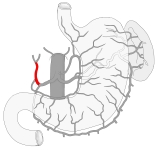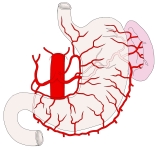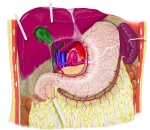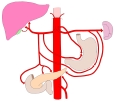
固有肝動脈 とは

・「 日本人体解剖学 」では、腹大動脈の臓側枝の無対性の動脈の1つとしている。
・ 英語では「 hepatic artery proper 」と表記されることもある。
以下は「 日本人体解剖学 」の解説文となる。
「 右胃動脈を分岐したのち、右上方に曲がり門脈の前、総胆管の左に沿い肝十二支腸間膜中を通り肝門にいき、ここで分岐して右枝と左枝となり肝臓の右・左葉に至る。」
 |
 |
 |
 |
固有肝動脈 |
胃周辺の動脈 |
腹大動脈(前面) |
腹腔の動脈 |
 |
 |
|
|
腹腔動脈~
上腸間膜動脈 |
|
|
|

以下は固有肝動脈の枝を簡単に表したものとなる。




以下は「 Wikipedia 」の解説文となる。
「 The hepatic artery proper ( also proper hepatic artery ) is the artery that supplies the liver and gallbladder. It raises from the common hepatic artery, a branch of the celiac artery.
【 Structure 】
The hepatic artery proper arises from the common hepatic artery and runs alongside the portal vein and the common bile duct to form the portal triad. A branch of the common hepatic artery –the gastroduodenal artery gives off the small supraduodenal artery to the duodenal bulb. Then the right gastric artery comes off and runs to the left along the lesser curvature of the stomach to meet the left gastric artery, which is a branch of the celiac trunk. It subsequently bifurcates into the right and left hepatic arteries. Of note, the right and left hepatic arteries may demonstrate variant anatomy. A misplaced right hepatic artery may arise from the superior mesenteric artery (SMA) and a misplaced left hepatic artery may arise from the left gastric artery. The cystic artery generally comes from the right hepatic artery.[1] 」
【 語 句 】
・ gallbladder : 胆嚢 ・ portal vein : 門脈 ・ common bile duct : 総胆管 ・ portal triad : 門脈三管 ・ gastroduodenal artery : 胃十二指腸動脈 ・ supraduodenal artery : 十二指腸上動脈? ・ duodenal bulb : 十二指腸球部 ・lesser curvature : 小弯 ・ subsequently : その後 ・ variant : 異なる ・ superior mesenteric artery :上 腸間膜動脈 ・ cystic artery : 胆嚢動脈
【 イラスト掲載サイト 】
・ イラストや写真を掲載しているサイト-Ⅰ
・ イラストや写真を掲載しているサイト-Ⅱ
・ イラストや写真を掲載しているサイト-Ⅲ
・ イラストや写真を掲載しているサイト-Ⅳ

|